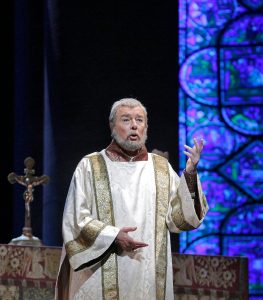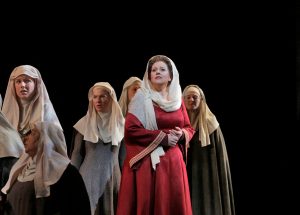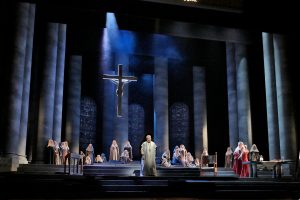“Murder in the Cathedral”: A Triumph for Ferruccio Furlanetto
A classic struggle of church and state: claiming allegiance to Divine authority, Roman Catholic bishops adamantly oppose the will of the head of state. That scenario may bring to mind the recent conflict between President Obama and the Roman Catholic hierarchy over certain aspects of Obamacare.
It also describes the central theme of Italian composer Idlebrando Pizzetti’s Murder in the Cathedral, San Diego Opera’s latest production of the 2013 season, which opened Saturday (March 30) at Civic Theatre. Based on a crucial event in English medieval history, the opera depicts the assassination of the Archbishop of Canterbury, Thomas Becket, by agents of the ruling monarch, Henry II, and the immediate events that led up to that brazen murder.
If the opera Murder in the Cathedral does not ring a bell of recognition, no one need apologize. Neither this 1958 opera nor Pizzetti’s other 15 operas are regularly produced in the U.S. or Europe, although, of his obscure canon, Assassinio nella cattedrale (its Italian title) is the one that may prevent his claim on opera history from disappearing entirely.
San Diego’s new production gave Pizzetti first class treatment: a strong cast, robust and colorful orchestral support, a lofty, atmospheric set design and richly textured costumes. It is an opera of great sonic beauty, and although it was written after the death of the 12-tone composer Arnold Schoenberg, its lush harmonic idiom never even flirts with the atonality that 20th-century avant garde composers saw as their starting point.
Murder in the Cathedral has many virtues, but it also has a serious fault: although it is based on a highly dramatic act—Becket is brutally killed in front of the cathedral altar—the opera lacks a propelling dramatic arc. Not only is the opera’s conclusion announced by the title, but the archbishop’s martyrdom is treated as inevitable, telegraphed from the opening chorus and underscored at every turn.
Instead of portraying the raging power conflicts between Becket and King Henry, the opera, which closely follows T. S. Eliot’s 1935 play Murder in the Cathedral, instead delves into Becket’s internal struggles that lead to his acceptance of matyrdom. Like John Adams’ second opera, The Death of Klinghoffer (yes, another historically rooted story of an unjust murder), Pizzetti’s opera is about the conflict of ideas rather than the actual conflict of people and events. Perhaps both of these operas should be done in concert form—it would save the expense of staging and still make the composer’s case in a compelling way.
Can there be any doubt that this role of Thomas Becket is a Christmas gift from Tiffany’s for the right bass? Or the slightest doubt that the Italian bass Ferruccio Furlanetto at this stage of his career is exactly the right singer to portray Becket?
The deep end of Furlanetto’s instrument is rich and mellow, and it gains even more power as it ascends to a beautiful baritonal cantabile at its summit. When defending himself against his accusers, he was stentorian without resorting to bluster, and in his gentle Christmas Day homily, he floated a gentle yet ardent legato line that could pierce even the coldest of hearts. A demanding role—Becket is on stage most of the time—Furlanetto’s archbishop resounded with authority and compassion.
Of next importance was the women’s chorus, portraying both the fealty and anxiety of the archbishop’s flock with confident
radiance: kudos to San Diego Opera Chorus Director Charles F. Prestinari. Soprano Susan Neves, a gleaming, dramatic soprano infused her role of First Chorus (a soloist functioning as a Greek chorus, not unlike the Male Chorus and Female Chorus soloists in Benjamin Britten’s The Rape of Lucretia) with a passion of which the opera needed more.
Among the Archbishop’s four Tempters (all of whom live in his mind), baritone Malcolm MacKenzie stood out with his dependably resonant tonal command and dramatic assurance. Bass-baritone Ashraf Sewailam and bass Kevin Langan proved dramatically persuasive as Tempters, although they did not match MacKenzie’s vocal prowess.
Joel Sorensen’s slightly reedy tenor made the First Tempter appear flighty, but Allan Glassman’s clarion tenor made a more inviting Herald. In this opera, it appears that Pizzetti lavished his best vocal writing on the lower male voices.
Making his local debut in the San Diego Opera pit, Italian conductor Donato Renzetti gave admirable shape and drive to Pizzetti’s magnificent orchestra score, as varied and brightly hued as any Ottorino Respighi tone poem. A few times I detected references to the score of Bartók’s Bluebeard’s Castle; throughout the evening, the orchestra itself proved nothing less than splendid.
Taking on the added role of stage directing this opera, Company General and Artistic Director Ian Campbell relied on artfully layered tableaux to organize many of the scenes, an effective choice. He kept the women’s chorus moving, however, to avoid giving the impression of the opera as an oratorio in disguise. The opera’s second act Intermezzo, a portion of the Christmas morning cathedral mass, was presented with unaffected grace and dignity.
Ralph Funicello’s striking single set, three tall, stylized gothic stained glass windows that suggested a cathedral apse, effectively[php snippet=1] framed all of the action. The tall columns added a note of austere grandeur, and the medieval stained-glass image of the sainted Thomas Becket blown up in vivid colors made a stunning scrim. Denitsa Bliznakova’s flowing period costumes had enough subtle color and variety to consistently engage the eye, and her liturgical vestments exhibited a refreshing medieval pomp—never to be confused with the Baroque glitz favored by a recently retired successor to St. Peter.
Alan Burrett’s generaly subtle lighting scheme exhibited occasional bursts of unexpected bright colors that certainly invited a sense of transcendence.
There were many times during Pizzetti’s Murder in the Cathedral that I thought of Francis Poulenc’s Dialogues of the Carmelites, written in the same decade of the 20th century on a similar theme of conflict between church and state. Poulenc, of course, had the great advantage of the inherently dramatic nature of Georges Bernanos’ play on which he based his opera of martyrdom. Poor Pizzetti—the crass impaling of the archbishop with multiple swords could never hold a candle to Poulenc’s noble procession of nuns to the guillotine, with their voices dropping out one by one from the “Salve Regina” chant.
[box] This production continues with 7:00 p.m. performances on April 2 & April 5, 2013. On Sunday, April 7, 2013, the last performance begins at 2:00 p.m. Tickets: 619.533.7000 or sdopera.com.[/box]

Ken Herman, a classically trained pianist and organist, has covered music for the San Diego Union, the Los Angeles Times’ San Diego Edition, and for sandiego.com. He has won numerous awards, including first place for Live Performance and Opera Reviews in the 2017, the 2018, and the 2019 Excellence in Journalism Awards competition held by the San Diego Press Club. A Chicago native, he came to San Diego to pursue a graduate degree and stayed.Read more…






A generous review, although Mr. Herman goes a little far when he lavishes so much praise on the orchestra, where shimmer too often obscured urgency, and lassitude retarded motion. Not to be pedantic, but be careful about those Greek words – there is no such thing as a kudo; “kudos” is a Greek noun generally meaning praise (although it happens to end in the -s form which we associate – again, generally – with plurals in English.)